I 1 I Sets, Relations, and Languages
TaProblem 1.1.1
(a) true. Every set is a subset of itself, including 0.
(b) false. 0 has no members, not even •
(c) true. 0 is certainly a member of {0}, the set whose one and only member is 0.
(d) true. 0 is a subset of any set
(e) true. {a,b,c,{a,b}} is the set whose elements are a, b, c, and {a,b}; clearly {a,b} is one of these elements
(f) true. The members of {a, b} are a and b, each of which is a member of {a, b, {a,b}}.
(g) false. The members of {a, b} are a and b, but every element of the powerset 2{a,{a,b)) is a set
(h) true. Because {a,b} € {a,b,{a,b}}, it is also true that {{a,b}} ~ {a,b,{a,b}} By definition of the powerset, {{a, b}} € 2la5{a,0)},
(i) false. {a,b, {a,b}} - {a,b} = {{a,b}}, not {a,b}
Problem 1.1.2
(a) {3,5}
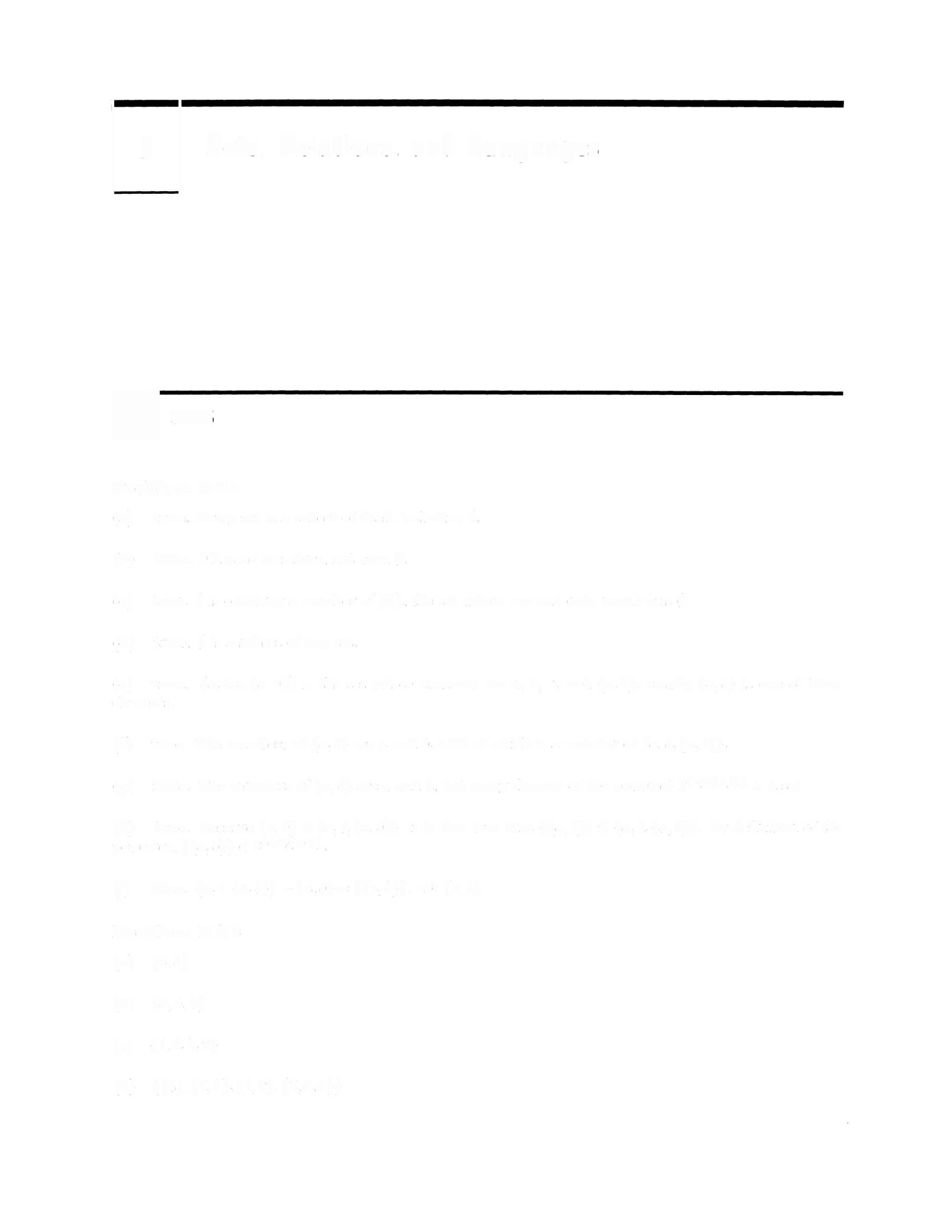
(b) {3,5,7}
(c) {1,2, 7,9}.
(d) {{8},{7,8},{8,9},{7,8,9}}
(e) {{}} (which is, of course, the same as {0))
Problem 1.1.3
(a) First, we show the direction Suppose that x E AU(BnC) Then, by the definition of set intersection one of two cases applies: either € A or € B n C
Suppose the former. Then, because € A, we know by the definition of set union that € A U B and that x EAU C Because xis in both AU Band AuC, by the definition of intersection, we conclude that €(4uB)(4uO)
On the other hand, suppose the latter - that a € B n C. In this case, by the definition of intersection, it is true that € B and € C Applying the definition of union twice gives us that a € AU B and € Au C From this, by the definition of intersection, we have € (AU B) n (AU C)
Now we show the C direction Suppose that € (AUB) n (AUC) Then, by the definition of intersection, €AUBand€AUC
Suppose that € A. Then, by the definition of union, a € Au(BnO).
On the other hand, suppose a A. Since € AU B, it must be the case that € B. Similarly, because a€AUC,it must be true that a € C Thus, by definition of intersection, a € BC Then, by definition of union, € A U (B n C)
(b) Suppose € A(BUC) Then by definition of intersection € A and € (BUC) By applying the definition of union to the latter, either z € B or € C
Suppose a € B. Then, because € A, by definition of intersection € An B. By definition of union, then, a e (AB)u(AnC).
On the other hand, suppose € C Then because € A, by definition of intersection € An C By definition of union, then, z € (An B) U (An C)
Suppose € (An B) U (An C) Then either z € An B or x E An C Without loss of generality, suppose € An B. Then € A and x EB, by definition of n. Because € B, by definition of U, a € BU C. Because both a € A and z c BC, by definition of n, a € An(BUC).
(c) Suppose x E An (AU B). Then, by definition of intersection, z € A and € (AU B) Since all we need to prove is that € A, we are done
Suppose € A Then, by definition of union, € AU B By definition of intersection, € An(AU B)
(d) Suppose a A. Then, by definition of intersection, A n B Since neither x E A nor € A B, by definition of union, Au(AnB)
Suppose € A. Then by definition of union, z € AU(AB)
(e) Suppose a € A--(BnC). Then a € A but q (BC). By definition of intersection, either B or a q¢ C. Suppose, without loss of generality, that a B. Then, because € A but a q B, write € A B, by definition of set difference. By definition of union, then, € (A-B) U (A- C)
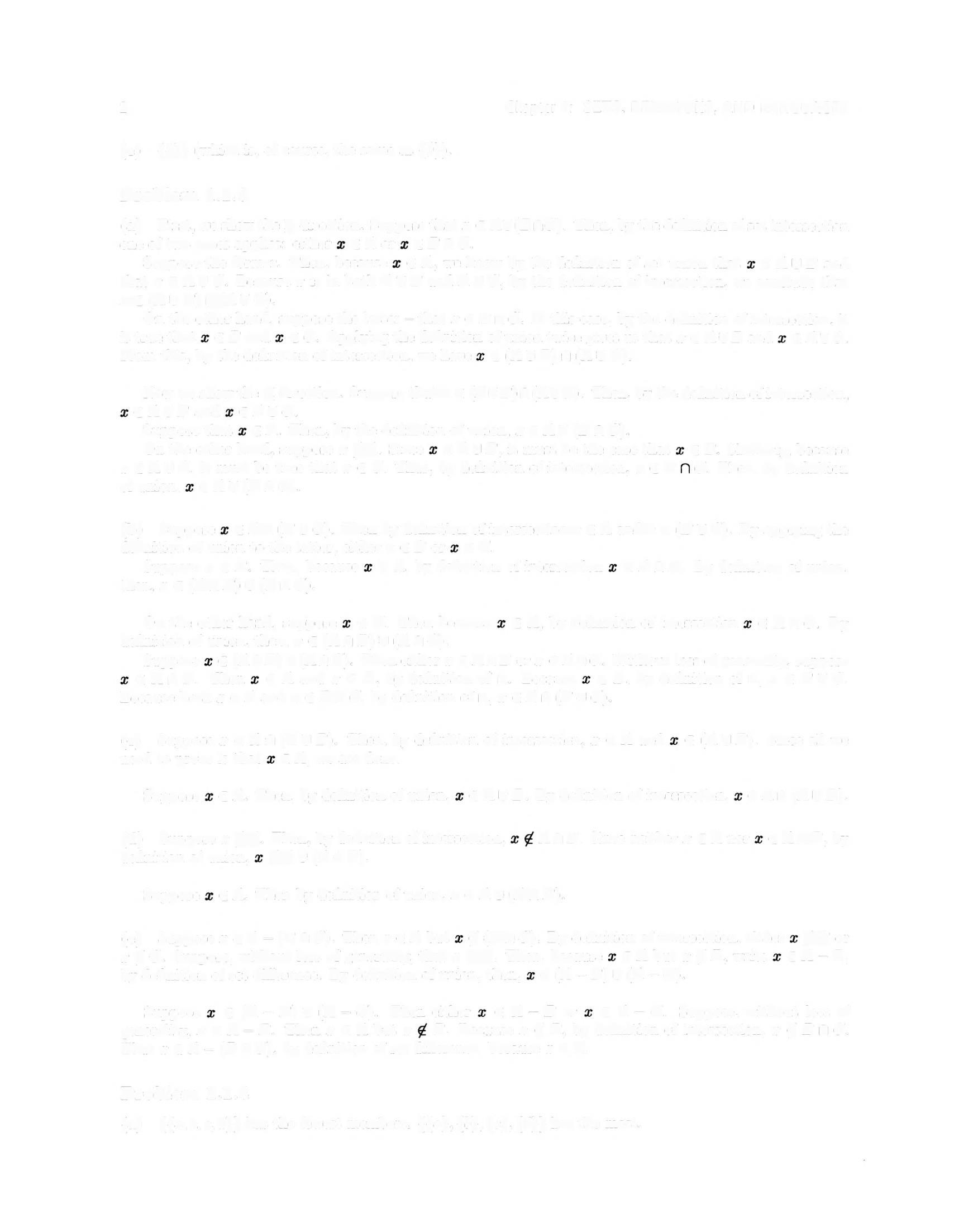
Suppose € (A - B) U (A- C). Then either € A-B or € A-C. Suppose, without loss of generality, a € A B Then a € A but a B Because a q B, by definition of intersection, a q B nC Thus a € A - (B n C), by definition of set difference, because a € A.
Problem 1.1.4
(a) {{a,b,c,d}} has the fewest members {{a}, {b}, {c}, {d}} has the most
2
Chapter 1: SETS, RELATIONS, AND LANGUAGES
(b) The following partitions have exactly two members: {0,{a,b,c,d}} {{a},{b,c,d}} {{b},{a,c,d}} {{c},{a,b,d}} {{d},{a,b,c}} {{a,b},{c,d}} {{a,c},{b,d}} {{a,d},{b,c}}
BRELATIONS AND FUNCTIONS
Problem 1.2.1
(a) {(1,1,1),(1,l,2),(1,1,3),(1,2,1),(1,2,2),(1,2,3)}
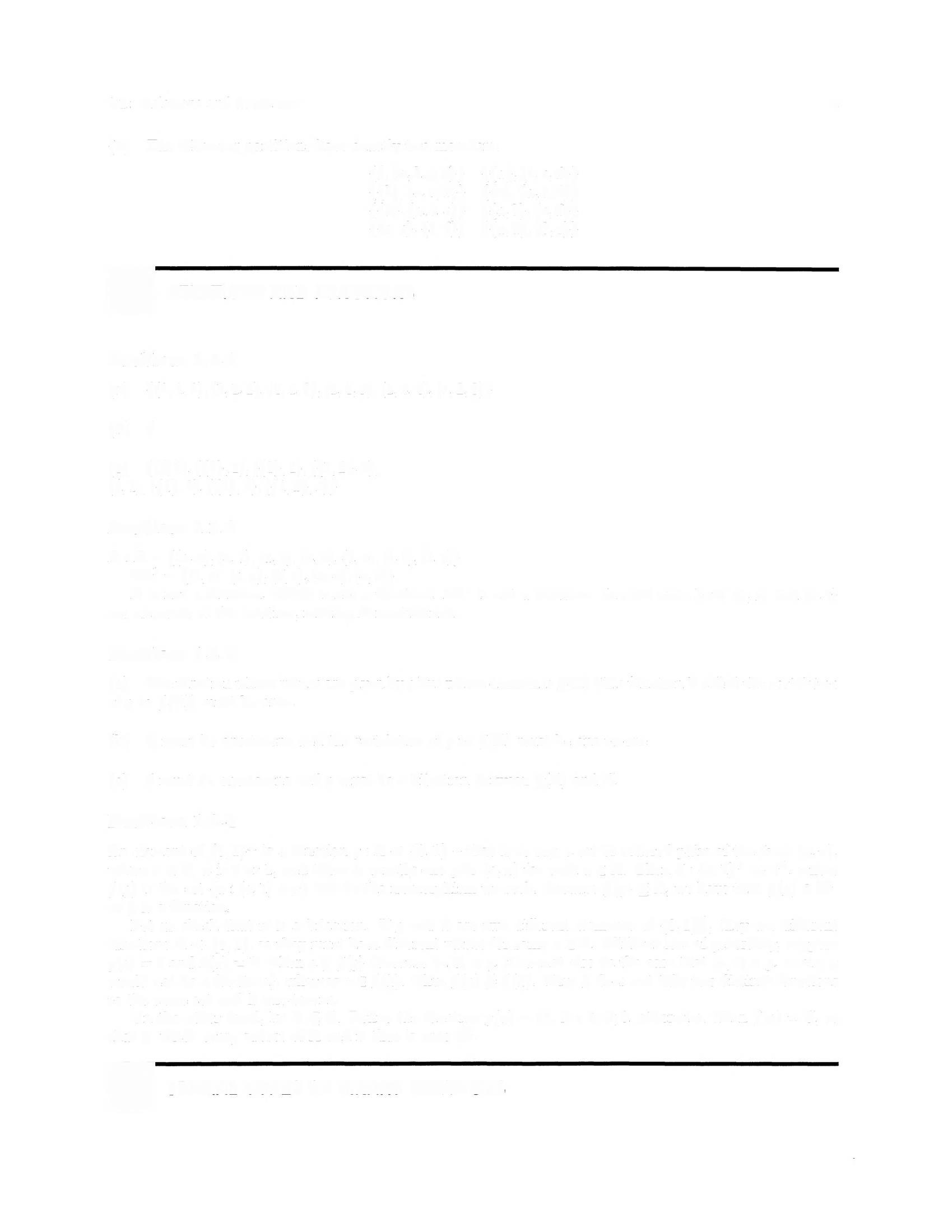
(b) 0
(e) {(0,1),( {1}, 1), ( {2),1),( {1, 2),1), (0,1),({1},2),({2},2),({1,2},2)}
Problem 1.2.2
RoR={(a,a),(a,b),(a,c),(a,d), (b,a), (b,b), (b, c)} R'={(b,a),(c,a),(d,c),(a,a),(a,b0)} R is not a function. o is not a function. R' is not a function. In each case, both (a,a) and (a, b) are elements of the relation, making R multivalued
Problem 1.2.3
(a) The function whose values are given by g but whose domain is f(A) (this function is called the restriction of g to f(A)) must be onto
(b) f must be one-to-one and the restriction of g to f(A) must be one-toone (c) f must be one-to-one and g must be a bijection between f(A) and C
Problem 1.2.4
An element of {0,1}' is a function g:A -» {0,1} - that is to say, a set of ordered pairs of the form (a,n), where a € A, n is 0 or 1, and there is exactly one pair (a,n) for each a € A. Then f: {0,1}° » 2', where f(g) is the set {a: (a,1) € g} will be the isomorphism we seek Because f(g) C A, we have that f(g) € 2, so f is a function
Let us check that it is a bijection If g and h are two different elements of {0,1}, they are different functions A-»{0, 1}, so they must have different values for some a E A Without loss of generality, suppose g(a) = 0 and h(a) = 1. Then a f/. f(g) (because (a,O) €g, it cannot also be the case that (a, 1) €g, or else g would not be a function), whereas a E f(h) Thus f(g)-=/:- f(h) Thus f does not take two distinct functions to the same set and is one-to-one
On the other hand, let S ~ A Define the function g(a) = {1, if a E S; 0, otherwise Then f(g) = S, so that f "hits" every subset of A and is thus is onto 2.
BSPECIAL TYPES OF BINARY RELATIONS
1 2: Relations and Functions 3
Problem 1.3.1
(a)
(b)
(c) a @
(@) a @
Problem 1.3.2
(a) R is not reflexive, not symmetric, and not transitive S is symmetric, but not reflexive or transitive
(b) R U S is reflexive, but is neither symmetric nor transitive.
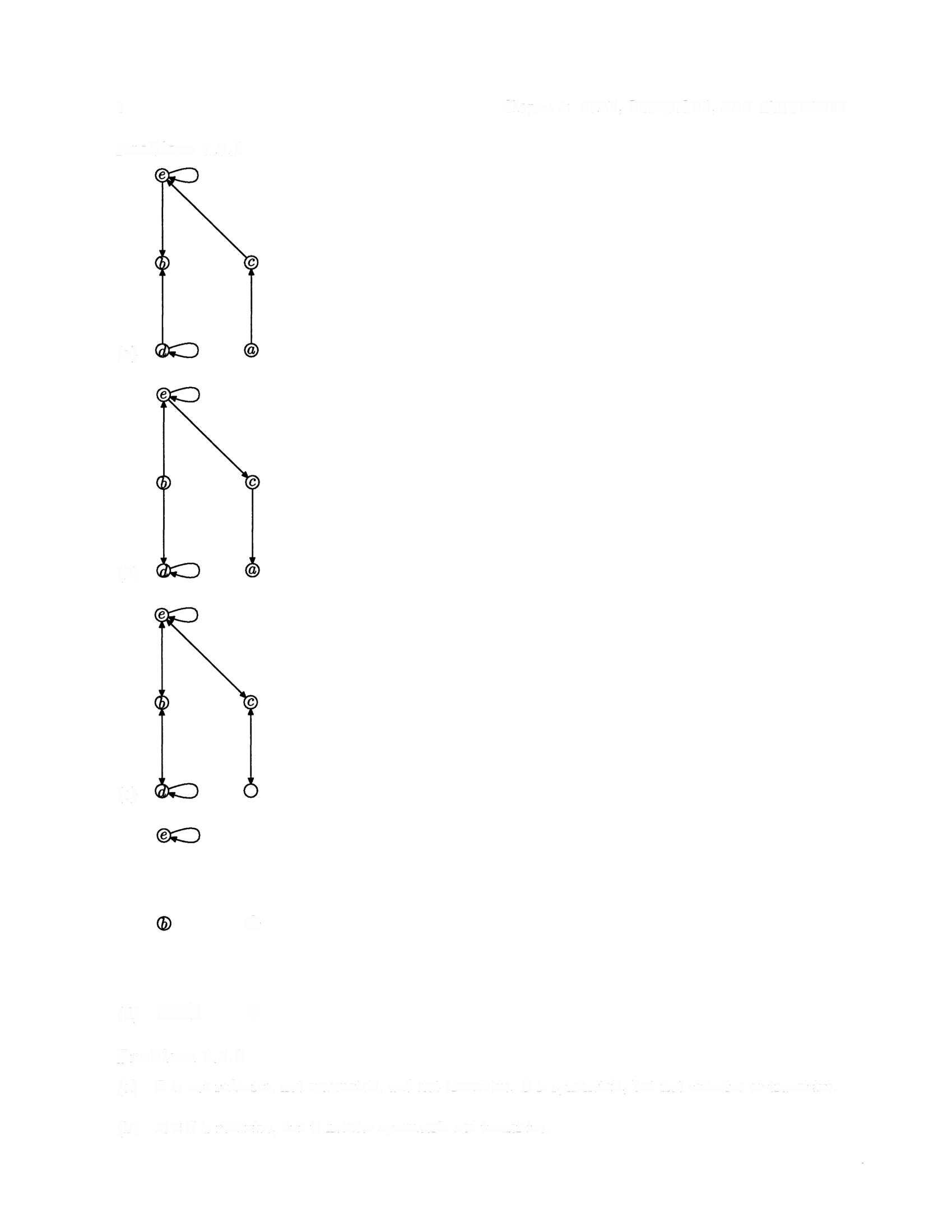
4
Chapter 1: SETS, RELATIONS, AND LANGUAGES
Problem 1.3.3
(a)
(b)
Problem 1.3.4
(a) R is not reflexive Take any random a €A-it is not the case that (a,a) ER
(b) R is symmetric. Since there are no a and b such that (a, b) E R, we do not need to worry about ensuring that (b,a) € R.
(c) R is anti-symmetric Since there are no a and b such that (a,b) € R, we do not need to worry about ensuring that (b,a) R.
(d) R is transitive Since there are no a,b, and c such that (a,b) ER and (b,c} ER, we do not need to worry about ensuring that (a, c) E R
Problem 1.3.5
For any a € A, it is true that f(a)= f(a), so (a,a) € R for all a € A Thus R is reflexive
Suppose (a, b} E R. Then f(a)= f(b}, from which we know that f(b) = f(a), so (b,a) € R. Thus R is reflexive.
Suppose (a, b} E R and (b,c) € R. Then f(a) = f(b} and f(b) = /(c), so that /(a) = f(c), making (a, c) € R Thus R is transitive
Problem 1.3.6
(a) R is a partial order R is reflexive because every number is divisible by itself R is anti-symmetric because if bis divisible by a (with a =I b}, then a <b, so it cannot be the case that a is divisible by b R is transitive because if b is divisible by a then b =na, and similarly if c is divisible by b then c = mb Then c = nma, so that c is divisible by a R is not a total order - for many pairs of numbers a and b,i it is not the case that neither a is divisible by b or that bis divisible by a (for example, a =2and b = 3}
(b) R is not a partial order, since it is not anti-symmetric ((1,2),(2,1)) € R and ((2,1),(1,2)) € R, but (1,2) 4 (2, 1). Since R is not a partial order, it is also not a total order
(c) R is not a partial order, since it is not transitive (1,2) € R and (2,3) € R, but (1,3) R Since R is not a partial order, it is also not a total order.
(d) R is not a partial order, since it is not anti-symmetric. "pizza, at five letters, is no longer than "bagel", also five letters But "bagel" is also no longer than "pizza Since "pizza" 4 "bagel, R is not anti-symmetric Since R is not a partial order, it is also not a total order

1.3: Special Types of Binary Relations 5
Chapter 1: SETS, RELATIONS, AND LANGUAGES
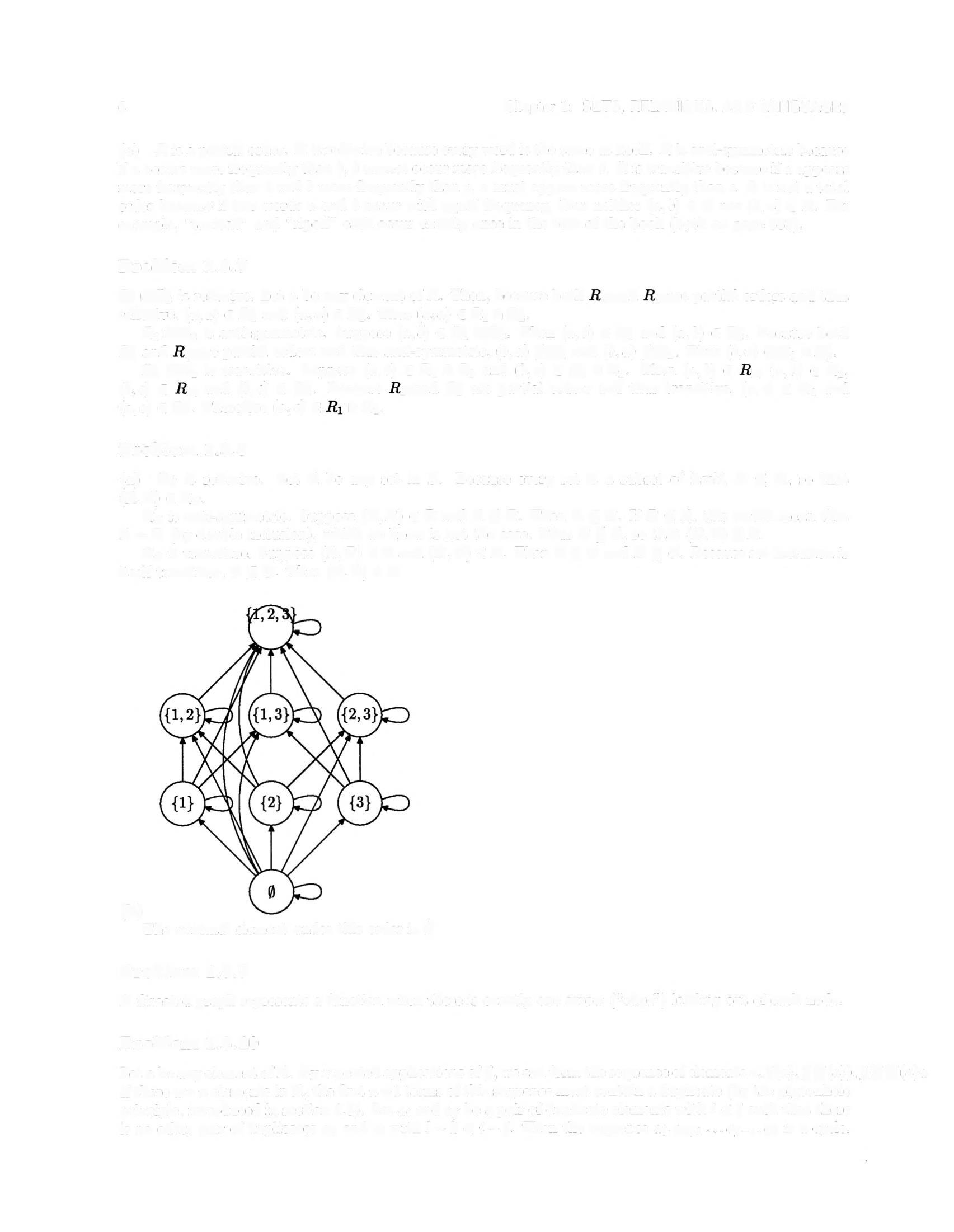
(e) Risa partial order. R is reflexivebecause every word is the same as itself. R is anti-symmetric because if a occurs more frequently than b, b cannot occur more frequently than b R is transitive because if a appears more frequently than b and b more frequently than c, a must appear more frequently than c R is not a total order because if two words a and b occur with equal frequency, then neither (a, b) E R nor (b, a) € R For example, "taxicab" and "ripoff" each occur exactly once in the text of the book (both on page 332)
Problem 1.3.7
R R is reflexive Let a be any element of A Then, because both and are partial orders and thus reflexive, (a,a) € R and (a,a) € R Thus (a,a) € R, nR
R, R» is anti-symmetric Suppose (a,b) € R R Then (a,b) € R and (a, b) € ». Because both R and are partial orders and thus anti-symmetric, (b,a) R and (b,a) R». Thus (b,a) R, nR
R R» is transitive Suppose (a,b) € R, n R, and (b,c) e R nR» Then (a,b) € , (a,b) € Ra, (b,c) € , and (b,c) € ». Because and R are partial orders and thus transitive, (a,c) € R, and (a,c) € R. Therefore (a,c) € nR»
Problem 1.3.8
(a) Rs is reflexive. Let A be any set in S. Because every set is a subset of itself, A CA, so that (A,A) € Rs
Rs is anti-symmetric. Suppose (4,B) € R and A 4 B Then A g B If B g A, this would mean that A=B (by double inclusion), which we know is not the case. Thus B g A, so that (B, A) q R
Rs is transitive Suppose (A,B) € R and (B,O) € R Then Ag B and B g C Because set inclusion is itself transitive, A g C Thus (A,C) € R
(b) The minimal element under this order is 0.
Problem 1.3.9
A directed graph represents a function when there is exactly one arrow ("edge") leading out of each node
Problem 1.3.10
Let a be any element of A. By repeated applications off, we can form the sequence ofelements a, f(a), f(f(a)), f(f(f(a)a If there are n elements in A, the first n + I terms of this sequence must contain a duplicate (by the pigeonhole principle, introduced in section 1 5) Let a; and a; be a pair of duplicate elements with i < j such that there is no other pair of duplicates a and a with l --k <i -j Then the sequence a;,a+1 aj--1,a is a cycle
6
Problem 1.3.11
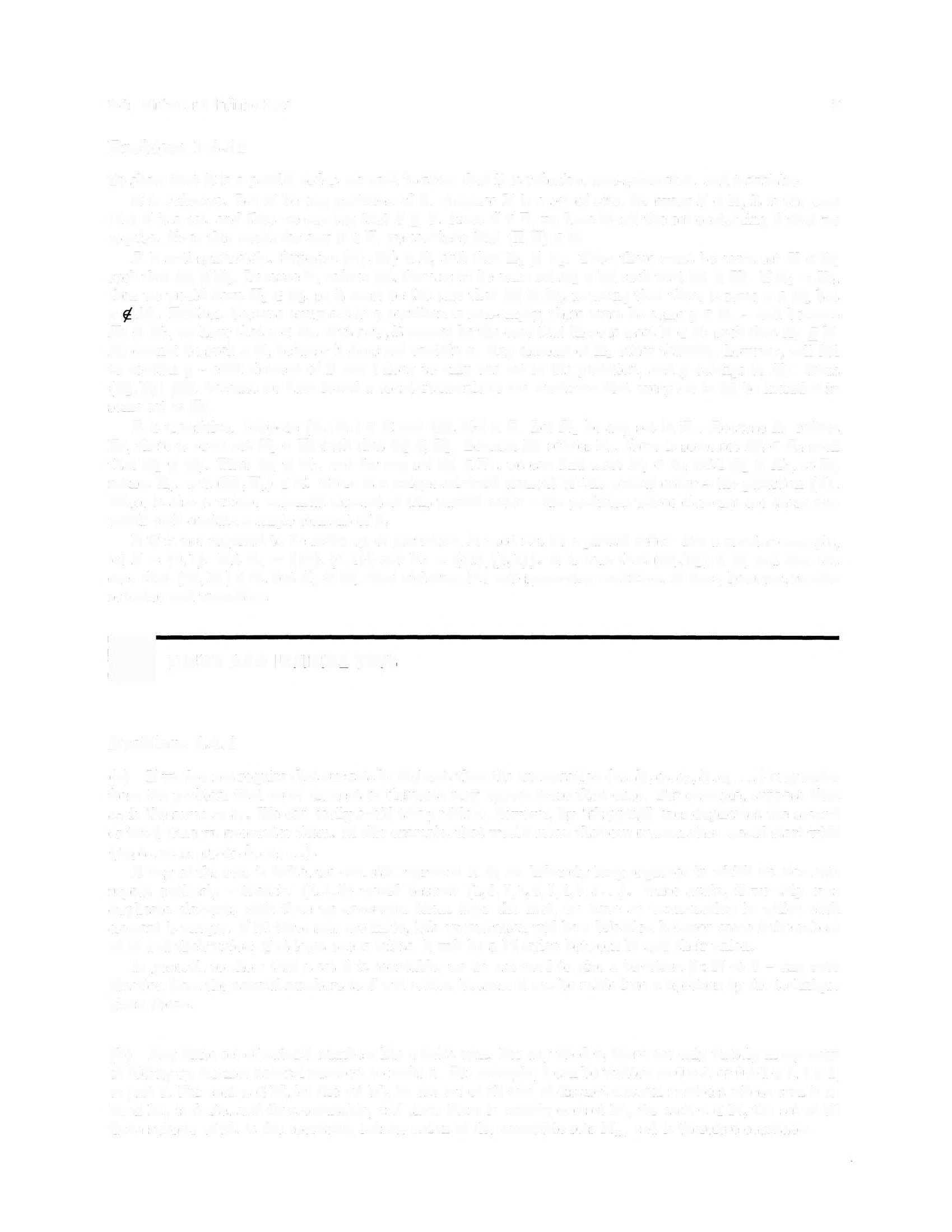
To show that Risa partial order, we need to show that it is reflexive, anti-symmetric, and transitive R is reflexive. Let II be any partition of S. Because II is a set of sets, for every S E II, it is the case that S is a set, and thus we can say that S g S Since S € II, we have found the set containing S that we require Since this works for any S E II, we conclude that (II, II) € R
R is anti-symmetric Suppose (II,,II) € R, and that II, ± II» Then there must be some set X € II such that X q I1. Because II, refines II, there must be some set X € I1 such that X CX. If X, =X, then we would have X; € II, so it must be the case that X Z X, meaning that there is some z € X but a X. Further, because every set in a partition is non-empty, there must be some y € X, - and because X CXa, we have that y € X». But now, it cannot be the case that there is a set Y € II, such that X» gY. X cannot be such a Y, because it does not contain a Any element of II, other than, however, will fail to contain y - each element of S can belong to only one set in the partition, and y belongs to X Thus (II,II) R, because we have found a counterexample to the condition that every set in II be included in some set in II.
R is transitive. Suppose (II,,Ia) € R and (II,Ilg) € R. Let X, be any set in II,. Because II, refines I, there is some set X» € II such that X C X. Because II refines IIg, there is some set g € IIa such that X C Xa. Thus X C Xs, and for any set X € II,, we can find a set Xe« € Ilg% with X C Xs, so II refines IIa, and (I,Ilg) € R. There is a unique minimal element of this partial order - the partition {S}. There is also a unique maxmial element of this partial order - the partition whose elements are those sets which each contain a single element of S
If P is not required to be made up of partitions, R need not be a partial order. For a counter-example, let S = {0,1} Let II, = {{0},{0,1}} and I1, = {{1},{0,1}} It is true that (I1,I1) € R, and also the case that (I1,II) € R, but II, ± II, thus violating the anti-symmetry condition R does, however, remain reflexive and transitive.
BFINITE AND INFINITE SETS
Problem 1.4.1
(a) If we don not require that our sets be disjoint, then the enumeration {ao, bo,co,a1,b,c, } may suffer from the problem that some element or elements may appear more than once For example, suppose that a0 is the same as b, We can easily avoid this problem, however, by "skipping" over duplicates the second or third time we encounter them. In this example, that would mean that our enumeration would start with {ao, bo,co,a1,01,02,b2,c, }
If any of the sets is finite, we can still represent it by an infinitely long sequence in which its elements repeat endlessly - that is, {1,3,5} would become {l,3,5,1,3,5,1,3,5 } Once again, if we skip over duplicate elements each time we encounter them after the first, we have an enumeration in which each element is unique If all three sets are finite, this enumeration will be a bijection between some finite subset of N and their union; if at least one is inifite, it will be a bijection between N and their union
In general, to show that a set Sis countable, we do not need to give a bijection f :N»S - any onto function from the natural numbers to S will suffice,because it can be made into a bijection by the technique given above
(b) Any finite set of natural numbers has a finite sum For any fixed n, there are only finitely many ways of adding up distinct natural numbers to make n. For example, 3 can be written as O +3, 0r O + 1 +2, 1 + 2, or just 3. For each n € N, let the set N n be the set of all sets of distinct natural numbers whose sum is n. Each N,, is finite, and thus countable, and since there is exactly one set N,, for each n € N, the set of all finite subsets of N. is the countably infinite union of the countable sets N,,, and is therefore countable
1 4: Finite and Infinite Sets 7
Problem 1.4.2
(a) Let f from N to the odd natural numbers be given by f(n) = 2n + l.
(b) Let f from the set of all integers to N be given by
f()= { 2a -1 a>0 <0

-2.z
(c) Let f:N xNx N -» N be given by r6,i= ;(+i+8°
Problem 1.4.3
(a) By (1), 0 E C. By (2), {0,0} e C. We can rewrite {0,0} as {0}. By (2), {0, {0}} E C.
(b) Take the set S from part (a) and consider the set SxS This set can be written out as {(0,0), (0, {0)),({0),0),({0), {0)))}.
(c) No Any set in C must be formed by one of the rules (1), (2), or (3) The empty set is finite, so rule (1) cannot make any infinite sets Rule (2) makes sets which contain either 1 or 2 elements (depending upon whether S = S), so rule (2) cannot make any infinite sets Rule (3) make sets which contain [Sr[]S] elements, which is finite when both S and S» are finite Thus rule (3) cannot make infinite sets unless there already are infinite sets already in C. This argument is a simple example of structural induction, a technique of proof that will be useful repeatedly
(d) C is countable Let C,, be the set of elements of C which can be formed by at most n applications of rule (1), (2), or (3), and define C to be 0. In forming Ci from C,, we have a choice of a finite number of rules to apply to a finite number of elements drawn from C,, If C,, is finite, so then is Ci. By mathematical induction (see chapter 1 5), C, is finite for all n Every element of C must be the result of a finite number of applications of rules, and thus belongs to C, for some n € N. Thus C is the countable union of the finite sets C,,, and is thus countable
Problem 1.4.4
Consider the triangle with vertices (0,0), (i + j-1, 0), and (0,i + j-1) This triangle contains all the ordered pairs whose sum is less than i + j The dovetailing method first visits all these pairs, then visits all pairs with sum i + j but first value less than i, and then visits (i,j)
The triangle contains A±z(ti± pairs, and there are i pairs with sum i + j but smaller first value. Thus there are
+3i+i m (2) ' 5l 3, 1
pairs enumerated before (i,j) Since the enumeration starts with 0, this means that (i,j) is visited mth
1.5 THREE FUNDAMENTAL PROOF TECHNIQUES
8
Chapter 1: SETS, RELATIONS, AND LANGUAGES
++»° +i
(ii++n,»(+es?
Problem 1.5.1
This result follows by induction on n. Basis step Suppose n = 0 Then:
0.1.2=0 0(2)(3) 4
Induction hypothesis Given n > 0 assume that for all k < n:
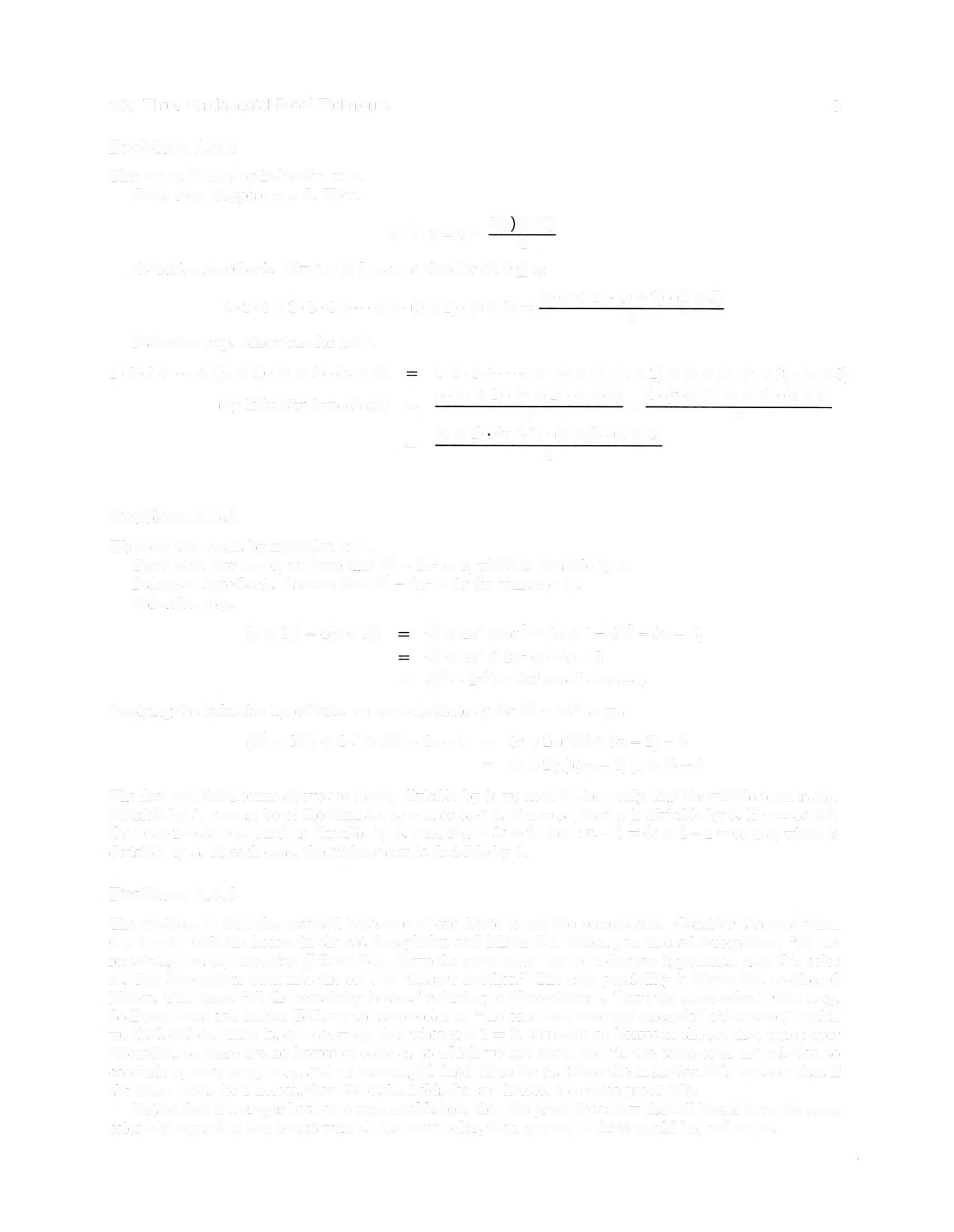
step Show true for n + 1
Problem 1.5.2
We show this result by induction on n. Basis step For n = 0, we have that n -- 4n? = 0, which is divisible by 3 Induction hypothesis Assume that n -- 4n? = 3r for some r € N
step
+ 1)--4(n+1) n+4n° +6n? +4n + 1-4n --8n -4)
n +4n? +2n? + --4n -3
= (n-4n?) +4n?° + 6n? 4n -3
Applying the inductive hypothesis, we can substitute 3r for n 4n? to get
(n--4n) + 4n° + 6n? -4n -3 = 3r +2n(2n + 3n -2) -3 = 3r +2(n)(2n - 1)(n + 2)-3
The first and third terms above are clearly divisible by 3; we need to show only that the middle term is also divisible by 3 n must be of the form 3s, 3s + 1, or 3s + 2 If n= 3s, then n is divisible by 3 If n= 3s + 1, then n + 2 = 3s + 3, which is divisible by 3 And if n = 3s + 2, then 2n 1 = 6s + 4-1 =6s + 3, which is divisible by 3 In each case, the middle term is divisible by 3
Problem 1.5.3
The problem is that the asserted base case of one horse is not the correct one. Consider the case when n + 1 = 2 Call the horses in the set Bucephalus and Mister Ed When you discard Bucephalus, "all the remaining horses," meaning {Mister Ed}, "have the same color" by the inductive hypothesis Call this color c Put Bucephalus back into the set and "discard another." The only possibility is Mister Ed, so discard Mister This time, "all the remaining horses," referring to {Bucephalus}, "have the same color " Call it c»
So Bucephalus and Mister Ed have the same color as "the ones that were not discarded either time," which we shall call cg. That is, c =c2 =cg. But when n +1 = 2, there are no horses in the set that were never discarded, so there are no horses of color cg to which we can apply the "is the same color as" relation to conclude c; = cs or c = cg, and no meaningful fixed value for cg Since the induction fails to show that if the claim holds for 1 horses, then the claim holds for two horses, the entire proof fails
Notice that if a proper base case were established, then the proof does show that all horses have the same color - if any set of two horses were all the same color, than any set of three would be, and so on
1.5: Three Fundamental Proof Techniques 9
=
1 2 3+2
Induction
1 · 2 • 3 + • • • + ((n +1)·(n+ 2) • (n
(by
1 · 2 3 + · · · + n · (n +1) (n + 2) + (n +1) (n + 2) • (n + 3) n · (n + 1) (n + 2) · (n +3) 4 (n + 1) (n + 2) • (n +3) = + 4 4 (n +1) (n + 2) • (n +3) (n + 4) 4
3 4+ +k (k+1) (k+2) :(k+1)·(k+2) (k +3) 4
+ 3))
inductive hypothesis)
Induction
(n












